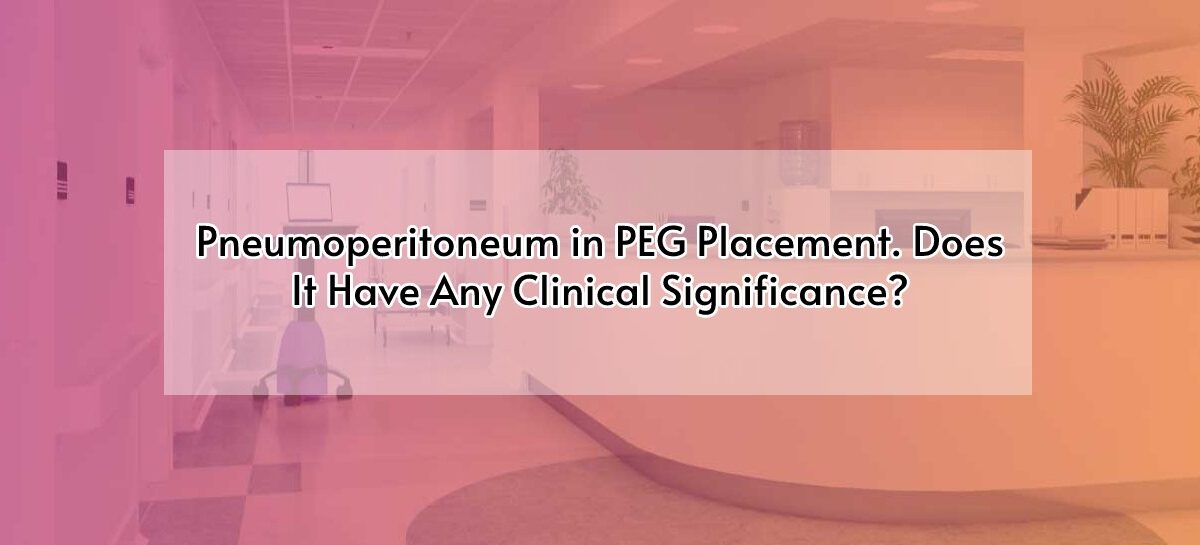PEG has become a method of choice for providing enteral access and nutritional support to patients who are unable to take oral feedings. Various complications have been known to occur after PEG placement including skin site infection acute hemorrhage, aspiration and perforation. Air that is insufflated at the time of PEG procedure by endoscopy and air that enters the peritoneal cavity through a puncture site on the gastric can also develop into Pneumoperitoneum.
INTRODUCTION
A 51 years gentleman came here with complaints of high grade intermittentfever x 1 day. No history of cough / cold / nausea / vomiting / loose stools / abdominal pain / chest pain / palpitation / sweating / decreased urine output.
PAST MEDICAL HISTORY
There was a history of recent cardiac arrest on 28.1.2021. Secondary toAWMI (STEMI) S/P CABG on 28.1.2021.plus IABP with PTCA to Proximal and Mid LAD. Post event he developed Hypoxic Ischemic Encephalopathy; following which a Tracheostomy tube was done.During the hospital stay, he developed Hepatitis and AKI.
Tracheostomy culture showed ESBL + Acinetobacter baumanii, for which started on IV Tigecycline as per culture and sensitivity reports.
He was started on PEG feed and was discharged.01.04.2021 in view of recurrent aspiration and bed bound state.
He was reviewed for PEG Tube replacement in view of a displaced PEG Tube on 02.06.2021. At this time he was prophylactically started on IV Piperacillin Tazobactum.
ON EXAMINATION
Patient Drowsy, Febrile, Poor Hydration
Pulse:158/min
BP:80/60mmHg
RR:28/min
SpO2:96% room air
Temp: 101 F
CBG:194 mg/dl
SYSTEMIC EXAMINATION
A: Post Tracheostomy Status. No signs of obstruction
B: B/L air entry, NVBS, Mild Distress
C: S1S2+,PSM+,JVP-normal, Pallor +, PPWF+
P/A: Distended,Resonant, BS+, PEG Tube Insitu
D: E4V1M3, B/L PERL 2mm
E: Tracheostomy Tube insitu. Clear. No secretions
BEDSIDE INVESTIGATIONS
ABG CHEM – 8
pH: 7.52 Na:146
pCO2: 25 K:4.2
pO2: 75 Cl:115
HCO3: 19.1 Glu: 143
TCO2: 20 BUN: 55
Lac: 1.28 Cr: 1.3
Hb: 7.8
PROVISIONAL DIAGNOSIS:
ACUTE FEBRILE ILLNESS To R/O SEVERE SEPSIS
PNEUMOPERITONEUM
In view of Temp:101 F, INJ.PARACETAMOL 1G IV was given
In view of BP 80/60mmHg, IVF NS 100ml bolus followed by 50ml/hr.
CT CHEST was done due to hemodynamic instability which showed:
- Right LL densities atelectasis
- No features suggestive of Covid 19
CT ABDOMEN was done to rule out GI Bleed which showed:
- Pneumotosis Intestinalis of the distal ileum
- Massive Pneumoperitoneum & Loaded Rectum
He was started with INJ.PAN IV Infusion @ 8mg/hr
16 Fr Foley’s Catheter kept, Stomach wash given
Blood Grouping and Typing was sent side by side
He was shifted to the CCU for further management.
IN the CCU 4 Units of PRBC were transfused in view of severe anemia [Hb: 7.8 gm/dl] and ongoing GI Bleed.
He was advised to withhold Anti-platelet and Anti Inflammatory and planned for Endoscopy.
Endoscopy done showed normal study and was suggested for Colonoscopy.
Colonoscopy showed Erosive Terminal Ileitis.
He was diagnosed to have GI Bleed- NSAID Enteropathy
PNEUMOPERITONEUM
Presence of air within the peritoneal cavity.
Cause
- The most common causes are
- Perforation of Abdomen viscus
- Perforated ulcer
- Benign ulcer
- Tumor
- Trauma
- Endoscopy Barotrauma
- Diverticulitis
- Sub phrenic Fat
- Appendicitis
- A Perforated Appendix Seldom
Symptoms
- Abdominal Pain with rebound tenderness and Guarding
- End Organ Dysfunction due to Septic Shock
- Nausea and Vomiting
- Loss of Appetite
- Decreased Urine Output
- Diarrhea
- Thirst/Bloating
Signs
- Double wall Sign(Presence of Air on both sides of the intestine)
- Riglers Sign
- Football (Abdominal cavity is outlined by gas from aperforated viscus)
- Cupola Sign(Gas accumulates in the central tendon of the Diaphragm)
- Hepatic EdgeSign(Cigar Shapedpocket of free airin the subhepatic region)
- Lucent Liver Sign(Collection of free intraperitoneal gas located anterior to the liver)
Pneumoperitoneum is also common in PEG Tube Insertion. Insufficient fixation of PEG Tube causes leakage of air through the gastric wall which enters free peritoneal space.
PEG Tube Replacement: Mainly due to High Intragastric Air pressure generated by endoscopic air insufflation in association with needle puncture of abdominal wall and stomach. Most of them tend to resolve within a week. They are usually detected on X-rays.
TREATMENT
Conservative Management. External binder kept 1cm away from abdominal skin after Gastrotomy fistula has formed and matured and periodic rotation of tube to verify that internal bumper is free.
CONCLUSION
A thorough history and physical examination combined with appropriate laboratory tests and radiological techniques are useful tools in identifying patients with Pneumoperitoneum. Every instrument or tube inserted into the body always has the risk of causing complications and it must always be kept in mind as It can be easily missed or masked by other clinical features. Pneumoperitoneum has a very subtle clinical presentation and in the absence of sepsis or perforation has no clinical significance. But it’s important for every clinician to keep it in mind in the background of sepsis cause once missed, we are in for many series of life threatening complications.
Acknowledgments
I would like to thank:
Dr.S.Vadivel Kumaran (Medical Gastroenterologist)
Dr.Aslesha (Head of Emergency Department)
Dr.Vetri(Emergency Physician)
For guiding me with the article.
 Dr. Mohammed Rashid
Dr. Mohammed Rashid
MRCEM Resident
Kauvery Hospital Chennai




